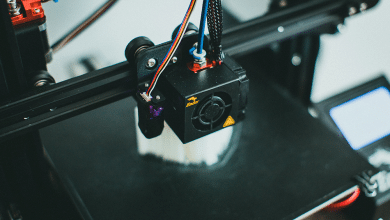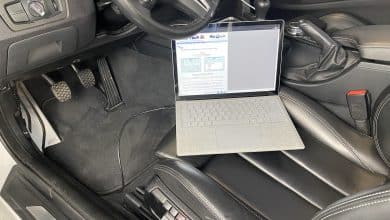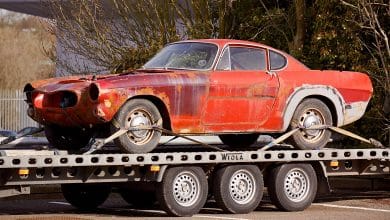An Enthusiasts Guide To Scan Tools

Every serious enthusiast, garage mechanic and race team find themselves needing an ODBII code scanner at some point. In this article we’ll look at some of our favorite options – which run from very inexpensive all the way to a tool that will rival what your favorite shop, and even dealership, can do.
Before we get into the tools, we’re going to talk a little bit about the terminology, what you should look for in a scan tool and what some of the advantages and disadvantages are of the various models. We’ll also briefly discuss some model specific considerations, particularly around German cars.
Scan tools also make great gifts for car enthusiasts. You know, if you are looking for something different for an enthusiast in your life and want to spend between $50-2000.
What Do Scan Tools Do?
Every cars ECU collects vital information about how well your car is operating. Some of these are standard across nearly all vehicle, others are specific to the brand and even model car. While most scan tools are designed to work with 1996 and up vehicles, the experience and the information you get can and will vary greatly.
Read ODBII Information and CAN BUS Information
At the basic level, generic errors codes stored in the primary ECU module and standard reporting information required for emissions and/or required by law are available via the ODBII port. At the most basic level, pretty much regardless of make and model, this basic information will be available via the ODBII port. Just about every scan tool, even the most inexpensive models will have access to this information.
In addition to error codes, this information likely includes things like speed, RPM, intake temperature and much more. There are a few reasons this information can be useful
- They can be used to aid basic diagnostics
- You can use them to get more detailed readings than the factory gauges, or display details you car does’t even have a gauge for.
- For more advanced users like track cars, they can provide digital displays of information
We’ll dive deeper into what you can get from your cars ECU in another blog post.
Scan and Clear Codes
Every scan tool primary function is to read ECU error codes and allow you to clear them. Depending on the tool the codes may be limited to the primary computer. When the ECU detects a problem or wants to record an event, it records a code. Scan tools will read these codes, generally a series of letters and numbers.
For newer cars with multiple computers, referred to as “modules” in most instances, the simpler scan tools may not read or clear codes from these additional modules. Examples are ABS, traction control, entertainment, active suspension and much more.
While every scan tool we discuss below can scan and clear codes, the inexpensive tools will only scan and clear the primary module. For newer cars, that’s rarely enough to effectively troubleshoot issues, so we recommend at least an intermediate scan tool. Particularly for German cars.
Reset Service Reminders
A common feature that drives enthusiasts and garage mechanics to need, or upgrade, their scan tools is the ability to reset service reminders. While some manufacturers let you reset service codes through the interface in the car without a tool, others, like Porsche do not or make it much of difficult to do. Scan tools may also allow you to reset service indicators the dash may note, for example 30/60K level services.
Generally the very inexpensive ODBII only scan tools and apps do not let you reset service reminders. Mid-level tools generally cover regularly scheduled service intervals and oil changes. Still, there are other basic services they may not work for: for example replacing a better. Many newer German cars require you to “register” the battery when replaced. The reason is that the ECU intelligent adjusts the alternator output to avoid unnecessary wear and overcharge on the battery. When you replace it, the ECU needs to know the new battery does not require the same level of compensation as an older battery.
Diagnostics
While most scan tools and codes cover basic diagnostics, more advanced troubleshooting is available on some mid-level and advanced scan tools. This can include the ability to trigger relays to test whether they are working. Examples often include enabling the ABS pump, cycling the AC module or activating moving vent. These diagnostics allow you to test individual components and relays to help determine where a failed component or electrical issue may be.
It is important to note that you can do damage to your and module, and even put yourself at risk using diagnostics on some tools incorrectly. For example you can force on a fan and burn it out, or disable your air bag. Other than reading information, we recommend only using the toggle/diagnostic features that make changes or switch relays if you are comfortable with what you are doing.
Replace Modules/Code Modules
Newer cars, particularly German cars, now have modules which are “coded” to the ECU. While in most cases this is as simple as the VIN number is programmed into high level modules that the ECU checks. The reason for this is primary anti-theft. If a module is stolen you can’t sell it or use it in another vehicle without access to the capability to re-program it for the cars VIN. Also, the module retains a history of all of the VINs it’s been programmed for so it can be traced back to a stolen car.
Of course, dealers don’t mind that this also makes it harder and more expensive to install used parts on your car. Even if you can find a working used part, if you don’t have the ability to program the module you’ll find yourself visiting the dealer and paying a fee to their service department to do it for you.
The ability to replace modules is primary a feature of the higher end scan tools, but we are starting to see some features trickle down to mid-range models.
Some scan tools and software allow you to “code” specific features in modules. Most module and ECU software is generic between models from the same manufacturer, and in some cases even regions of the world. Often features or modules available on other modules or in other places in the world can be used in your car simply by changing some settings. There are also “secret” menus that can be enabled with coding that offer additional customizations. These include things like changing what the buttons on your key fob does, to say rollup or down all of the windows, or to allow you to swap to JDM/GDM headlights.
While detailing each of these is well behind the scope of this article, do we have a guide illustrating some more details on the process of coding and it includes some specific examples for Audis and BMWs.
We should remind you, coding, like many advanced features with code scanning, does carry some inherit risks.
Calibration And Multi-Step Processes
ABS bleeding, air suspensions and other sensitive systems often need to be calibrated, bleed or have a specific procedure that should be followed to ensure they function properly. The more advanced scan tools can kick off these calibration or multi-step procedures. These features are generally available on the more advanced tools and are often brand and model specific.
What Considerations Are There When Choosing A Scan Tool?
In addition to the basic and high level features above, there are a few other things to think about when choosing the right scan tool for you.
Your Level Of Experience
If money was no object you’d just buy the best tool. And we certainly think that is an approach. However, if you are not really the do-it-yourself or do you don’t spend a lot of time wrenching on your cars, a higher end scan tool may be a waste of time for you.
If you are just getting into the process, we’d recommend you get a basic ODBII scanner with the minimum feature like code reading and service that meets the level of your current needs, as long as it works for your car. Start simple. Most of these tools are re-sellable, so you can recoup most of your money by selling to another enthusiast before moving up. Keep reading for why we might recommend this approach.
How Many Makes You Need It For
If you only have a single make or model you deal with, or all of your cars come from the same brand, this is a much easier evaluation. For most enthusiasts, even those of us crazy enough to have multiple cars plus daily drivers, changes are we’re hoping our scan tool is effective across all of our cars.
Some car manufactures, like BMW and Porsche, have some very specific scan tool needs and quirks. If you only have or only care about using the tool on these specific models, there are options that are designed specifically for them that provide better features for the money.
If you want it to work across multiple companies, either now or as a future proof there are a few things to look for when considering your scan tool choice:
- While general ODBII scanners will usually work for the basics across all 1996 newer cars, you may miss out on specific unique features you need.
- Even some mid-level code scanners over “multi-brand” or “single-brand” versions. The single brand versions are often significantly cheaper, but that is the catch. Some brands, particularly at the lower end of the mid-level price scale cannot be upgraded to support multiple brands.
- High mid-range and high ends models often support multiple brands, but even this can be confusing. Many of the higher end models, even when they support multiple brands, charge per brand. Bundles with all brands are available but add to the cost. While the ability to upgrade over time or as your needs change is great, it’s something to think about particularly if you are extending yourself to buy a higher end device. You may need to make additional purchases down the road.
- Some model or brand specific tools, like Durametric for Porsche and Bavarian Technic, have Pro version that are unlimited, but their enthusiast model only allows you to use it with up to 3 VINs. Also, tools like this are great, but they ONLY work with specific manufacturers.
Do You Need A Support Specific Features For Your Car Or Needs
If you are new to scan tools you may not yet know the answer to this, which is why we recommend a strategy for upgrades. But if you are an experienced enthusiast it may be worth shopping on the specific special features you need and matching the right scan tool to those needs.
We already mentioned features like the ability to change modules or code, as well as the things like suspension calibration and bleeding the brakes when you have an ABS system. Additionally, some cars may need a different connector or you need to connect directly to certain modules using a different port than the ODBII under the dash. A great example of this is most late 90s and 2000s BMWs requiring the “round connector” to access additional modules, particularly the ABS module. Also, some BMW models from that era require a different cable (a pin in swapped) in order to access certain information or features.
Your Risk Tolerance
A last, critical note is that some features and modules can be dangerous if used incorrectly. While not common, some, like being able to disable air bag modules, could be literally be risky to your health. Most risk is really around the fact that you could misconfigure something, or break a module and make it unusable, particularly by coding it incorrectly. We definitely recommend you be cautious if your scan tool has these capabilities but you are not yet familiar with them or their potential impacts.
Our Favorite Scan Tools For Car Enthusiasts And Garage Mechanics
While there are literally dozens of options from free software and Amazon/eBay cables all the way to access to the tools dealerships use, we put together a list of our favorite scan tools. Tools made this list because they:
- Work on multiple brands of cars
- Offer good, better, best level of features
- Run the spectrum of being inexpensive all the way up to VERY advanced at prices most enthusiasts can afford
- We’ve used them personally or have come recommended from people we trust
Of course, this isn’t intended to be an exhaustive list but it should give you a good idea of the features and price points out there.
Level 1: Inexpensive Bluetooth Scan Tools
If you are looking to spend $100 or are just getting started, a Bluetooth ODB2 adapter is the way to go. It can read codes from almost all 1996 and newer cars. Simply plug the adapter into the ODBII under your dash, connect to it via Bluetooth on your phone or tablet and then use an app to manage your car.
You then just use an app on your phone you can see and clear codes. There are a number of apps that can use Bluetooth adapters, but we primarily have been using Torque Lite. Why? It’s free and works.
Some Bluetooth adapters come with software, others are just the adapter. Also, we should note that most ODBII are pretty basic ODBII scan tools. They can read basic ODBII information, scan and clear codes. Most do not support resetting service lights, nor do they work with additional modules or provide car specific details.
Level 2: Handheld Scan Tools
If you think you’ll need something more advanced, or have already outgrown just an ODBII adapter, or want something that doesn’t require a phone or laptop, handheld scan tools are the way to. Most multi-brand tools run under $250 (and even less for brand specific models).
Unlike the generic Bluetooth adapter with free software, these can often do a lot more than just read codes. They can reset service indicators and even do advanced things like program battery changes and modules (on certain modules). They also are easy to move between vehicles and generally provide a little more detail than the free apps.
Level 3: Advanced Scan Tool
If you are looking for the scan tool for enthusiasts and consider yourself a prosumer (professional grade consumer), a an Advanced Scan Tool, usually running on tablet, likely impress you. Be warned, these often cost north of $500, and easily get over $1000. And if you want a name brand or true mechanics tools like snap on, the tool cost goes even higher.
Still, these professional level and advanced scan tools can often do things you usually would need to go to the dealer for. They are intended for the hardcore garage mechanic. Then generally include the ability to read and clear codes, diagnosis on major components, program modules and perform calibrations and multi-step procedures required for most cars.
Many of these tools work across multiple models, but may only include a few with purchase and require you buy access to additional components. Also while they cover 90% of the needs, it’s still possible you may want or need a model specific tool for certain types of coding or the last little bit of capability.




